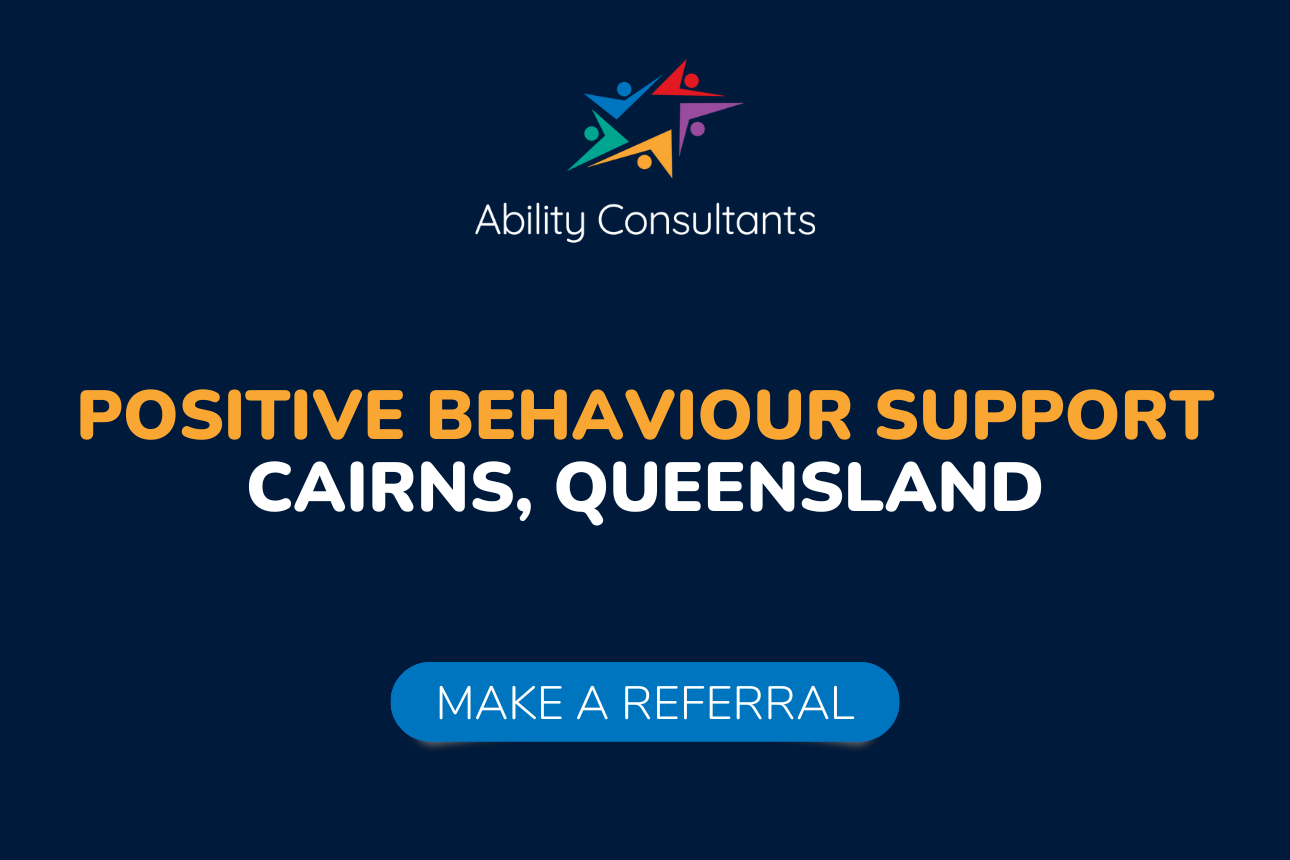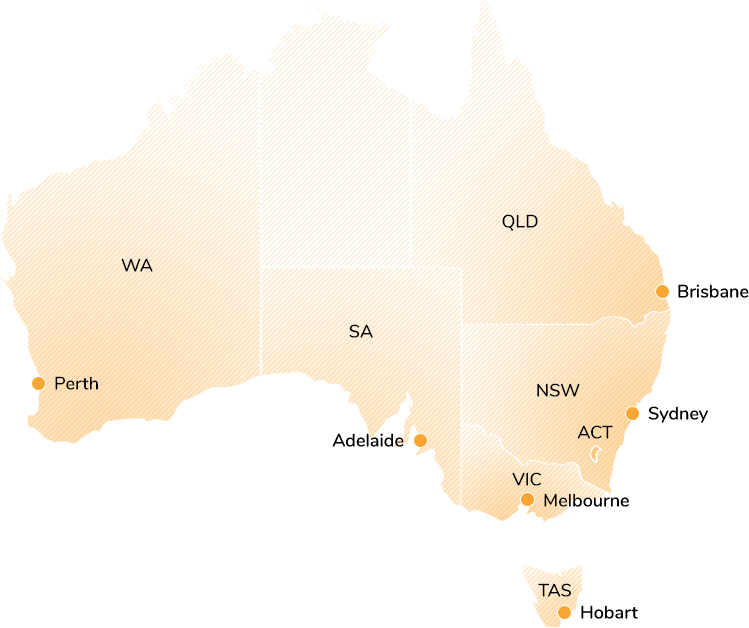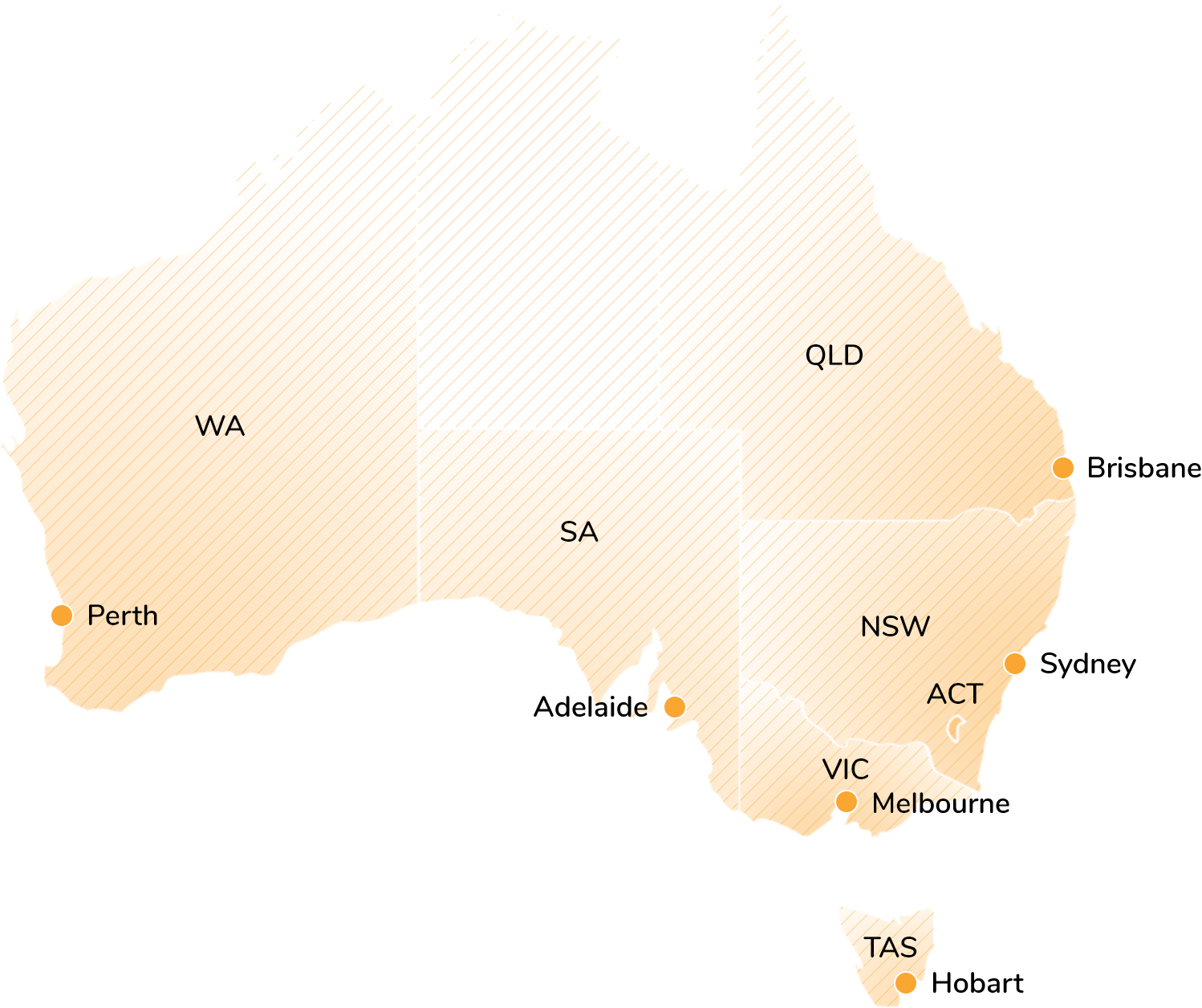The art of de-escalation: 10 tips for parents to manage autistic meltdowns

Story at a glance: We outline what an autistic meltdown might look like, list 10 ways to help someone experiencing an autistic meltdown and share how Positive Behaviour Support can help.
What is a meltdown?
According to Autism UK: “A meltdown is an intense response to an overwhelming situation. It happens when someone becomes completely overwhelmed by their current situation and temporarily loses control of their behaviour. This loss of control can be expressed verbally (e.g., shouting, screaming, crying), physically (e.g., kicking, lashing out, biting) or in both ways.”
Helping a person on the autism spectrum who is having a meltdown
As a Positive Behaviour Support (PBS) practitioner, my role often involves helping autistic individuals and their families effectively utilise Positive Behaviour Support strategies to manage and reduce the frequency and intensity of meltdowns, as part of the work to increase overall well-being and quality of life.
In this article, I offer Positive Behaviour Support-based insights and evidence-based strategies to help prevent, de-escalate and reduce the occurrence of autistic meltdowns. By understanding the underlying factors contributing to meltdowns and implementing effective strategies, families and caregivers can better navigate these challenging moments and provide the necessary support to help the person thrive.
Ultimately, a person-centred Positive Behaviour Support plan written and monitored by a behaviour support practitioner is the most effective way of ensuring autistic meltdown strategies are tailored to the unique needs, strengths, and challenges of the individual.
Behaviour support plans take into account the individual's specific circumstances, preferences, communication abilities, and sensory sensitivities, ensuring that interventions are personalised, evidence-based and effective.
What to look out for
1. Intense emotional response
A person might find themselves feeling extreme emotions such as anger, frustration, fear, or sadness. Sometimes the emotion involved is something that most people would see as positive, like excitement or joy. It is when the emotion is so strong that it’s overwhelming that we can see meltdowns occurring.
2. Difficulty communicating
Nobody is able to communicate at their best when overwhelmed, so during a meltdown, it is common to see people struggling to get their message across as well as they usually can. Even the most articulate person might find it hard to make themselves understood at these times.
3. Sensory overload
The source of overwhelm might be something the person feels through their senses, such as loud noises, bright lights, crowded spaces, or strong smells. Signs that this might be happening are: the person covering their ears, closing their eyes, or seeking a quiet space to get away from the overwhelming sensory experience. The person might be experiencing the sensory world differently from the way you do, so sometimes it takes a bit of creative thinking and a lot of empathy on our part to figure out what’s causing this overwhelm.
4. Self-soothing or distress actions
Some autistic individuals may use repetitive movements during a meltdown, such as rocking back and forth, pacing, hand-flapping, or hitting themselves. These behaviours can serve to make the person feel better, or might be an expression of distress. Either way, they might be a sign that the person is overwhelmed.
5. Loss of control
Autistic individuals may feel a loss of control over their emotions and behaviours during a meltdown. It might be hard for them to calm down, even when you try your best to help.
There is no one behaviour or one circumstance that defines a meltdown. It is a word often used to describe situations where a person becomes overwhelmed by something happening in their life and has difficulty coping with it. There might be many reasons why an autistic person might find themselves in a position where they’re overwhelmed, and each person has their own way of dealing with this stress and distress.
Autism: How to support a child experiencing a meltdown
Here are ten tips to help manage Autism Spectrum Disorder (ASD) meltdowns if you’re a parent or caregiver:
Learn to look for early warning signs
When we tune in closely to a person, we can often find signs that indicate they might be starting to struggle, and could soon become overwhelmed. While this looks different for each person, some common signs are:
- Withdrawing: Some children may exhibit signs of withdrawal before a meltdown occurs. They may become unresponsive, withdrawn, or appear to “shut down” to external stimuli.
- Physical signs of stress such as increased heart rate, rapid shallow breathing, sweating, or trembling.
- Increased sensory sensitivity: Your child may become more sensitive to sensory stimuli such as noise, lights or textures. They may cover their ears, close their eyes, or display signs of discomfort.
- Seeking solitude: Particularly common in crowded environments, your child may seek solitude or remove themselves from overwhelming stimuli by running away or hiding under furniture.
- A change from how they usually are: The person might become louder or quieter than usual, might be moving around more or less, or do things faster or slower than usual. Noticing the difference can be the important thing.
2. Identify triggers
Learn to recognise specific triggers that lead to meltdowns in your child, such as sensory overload, transitions, or changes in routine. Identifying triggers is not easy to do, and this is what your behaviour support practitioner can help with.
3. Create a safe environment
Create a calm and quiet space where your child can retreat during a meltdown to feel safe and secure. In the home, this could be a bedroom or a small tent filled with cushions and toys. If in public this could be a parent room in a shopping centre or your air-conditioned car.
4. Develop a routine
Establish and maintain a predictable daily routine to provide structure and stability, reducing the likelihood of unexpected triggers. Part of doing this is providing forewarning about transitions between settings and activities, and also about anything that is a change from the plan
5. Use visual supports
Utilise visual schedules, timers, and other visual supports to help your child understand expectations, changes and transitions throughout the day. A wall in the most visited area of the house, such as the kitchen, is a great place for your visual supports.
6. Teach coping strategies
Teach your child coping strategies such as deep breathing, using sensory tools such as fidget toys or weighted blankets, or practising mindfulness techniques to help them self-regulate during meltdowns.
7. Remain calm and patient
This is a big ask, but can be an absolute game-changer if you can do it! Stay calm and composed during your child's meltdown. Getting agitated or frustrated can escalate the situation further. Speaking in a soothing tone and offering reassurance provides an example for your child to follow about how to be calm, and also helps the person feel supported when they’re most in need.
8. Give space
Respect your child's need for space during a meltdown. Avoid overwhelming them with physical contact or excessive talking, and allow them time to calm down on their own terms. This also keeps you safe if their meltdown involves physical outbursts such as hitting and slapping.
9. Seek professional support
Consult with professionals such as a behaviour support practitioner who can provide a behaviour support plan containing guidance and strategies tailored to your child's specific needs.
10. Practice self-care
Take care of yourself physically and emotionally to better support your child during meltdowns. Seek support from other parents or support groups to share experiences and resources.
Remember that managing autistic meltdowns as a parent can be challenging, and it's essential to approach each situation with empathy, understanding, and flexibility. Every child is unique, so finding what works best for your child may require some trial and error.
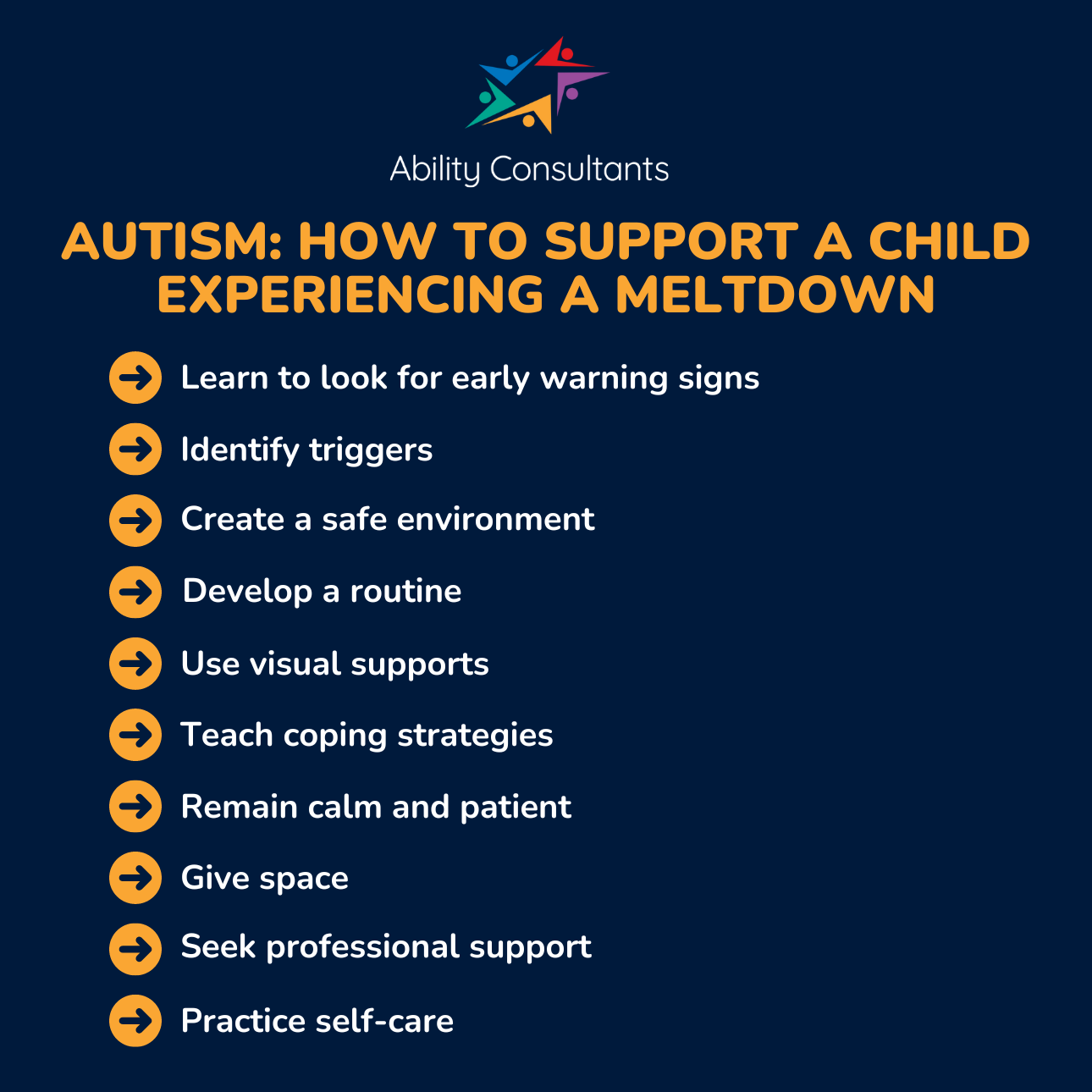
Positive Behaviour Support, Autism Spectrum Disorder and meltdowns
What is Positive Behaviour Support?
Positive Behavior Support is a person-centred approach aimed at improving quality of life and reducing behaviours that challenge by understanding and addressing their underlying causes, teaching skills, and promoting positive behaviours through proactive strategies, reinforcement, and collaboration among stakeholders.
How can Positive Behaviour Support help a child on the autism spectrum who is experiencing a meltdown?
Positive Behaviour Support can be highly effective in helping autistic individuals manage and reduce meltdowns across different age groups. Here's how Positive Behaviour Support can assist:
1. Functional assessment
Positive Behaviour Support begins with a thorough assessment to understand the underlying reasons for meltdowns. By identifying the specific factors that contribute to meltdowns, your Positive Behaviour Support practitioner can tailor interventions to address the specific difficulties faced by an individual effectively.
2. Proactive strategies
Positive Behaviour Support intervention starts by making adjustments so that the factors that make meltdowns happen aren’t as big a part of the environment This may involve creating structured schedules, using visual supports, and minimising sensory triggers in the environment.
3. Teaching coping skills
Positive Behaviour Support focuses on teaching autistic individuals ways to manage their emotions and stressors effectively. This may include teaching relaxation techniques, deep breathing exercises, or using sensory tools to self-regulate. Teaching these skills usually begins at times when the person is calm and receptive to new learning, with the goal of being able to apply the learning to challenging situations
4. Functional communication
Positive Behaviour Support helps individuals learn how to get their message across effectively and efficiently to others. This may involve using visual supports, augmentative and alternative communication (AAC) devices, or teaching specific communication strategies. For example, if a non-verbal child on the autism spectrum destroys their maths homework to communicate a lack of understanding, a replacement behaviour could be teaching the child to use visuals to communicate that they require help or a brain break.
5. Reinforcement of positive behaviours
PBS utilises positive reinforcement strategies to increase the occurrence of desirable behaviours and decrease the frequency of meltdowns and other behaviours of concern. This may involve using rewards, praise, or incentives for demonstrating appropriate behaviours and coping skills. As the person moves through different stages of life, they should be supported to develop intrinsically motivated behaviours.
6. Individualised support plans
Positive Behaviour Support involves developing individualised support plans tailored to the unique needs and strengths of each individual. These plans outline specific strategies, interventions, and supports to address meltdowns effectively and promote positive behaviour. These plans are often edited and re-written many times as a person moves through stages of life with the ultimate goal of the individual no longer needing the plan.
7. Collaboration and consistency
PBS emphasises collaboration among parents, caregivers, educators, therapists, and other stakeholders to ensure consistency in implementing support strategies across different environments. By working together as a team, individuals with ASD receive consistent support and reinforcement, which can help reduce the occurrence of meltdowns.
Overall, Positive Behavior Support provides a holistic and person-centred approach to addressing ASD meltdowns by focusing on understanding the individual, teaching alternative skills, and promoting positive behaviours through proactive strategies and collaboration among stakeholders.
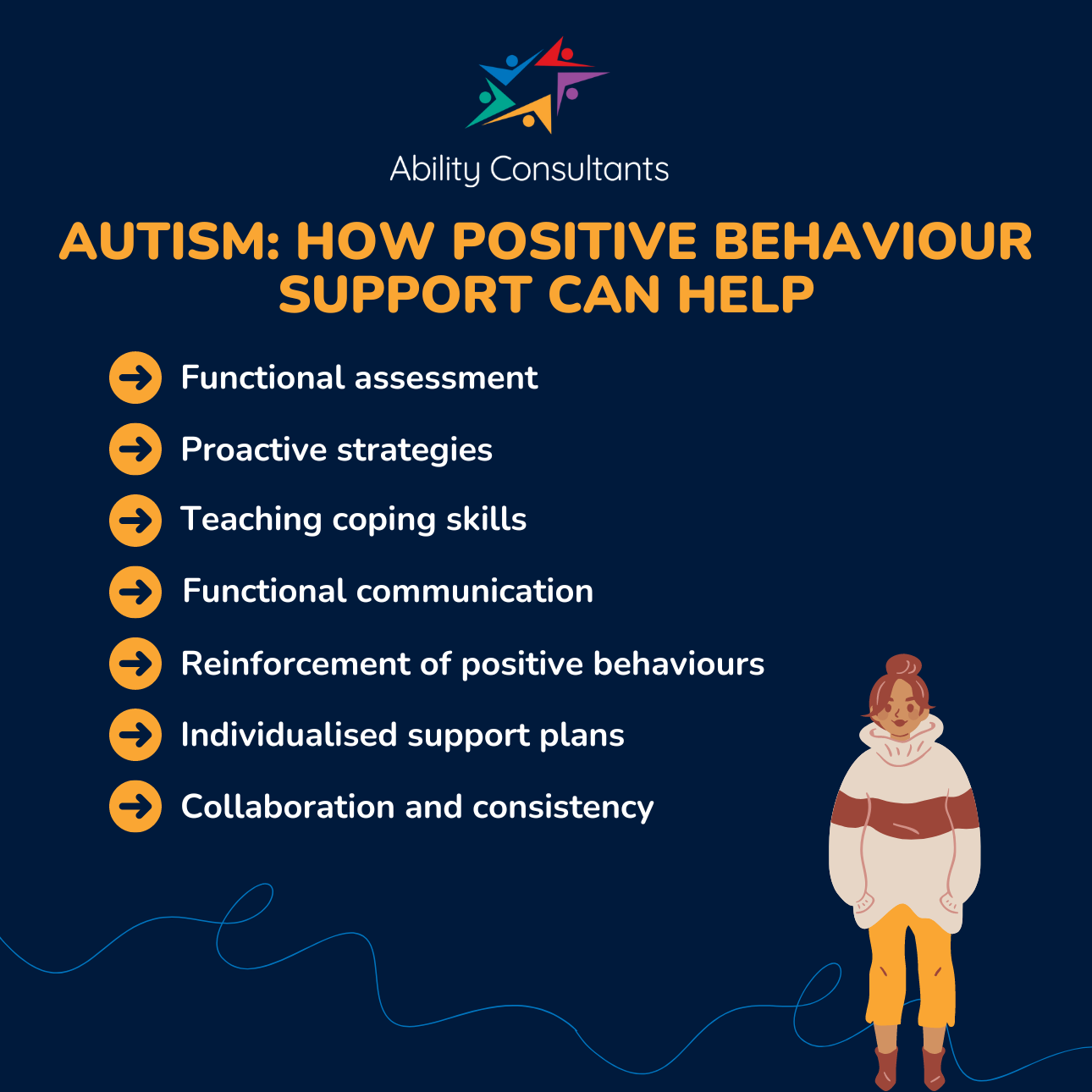
Positive Behaviour Support in Cairns, QLD
About your local behaviour support practitioner in Cairns
My name is Indi Taylor and I am a behaviour support practitioner in Cairns, QLD. I am passionate about supporting people with a disability to achieve their goals and live life to the fullest. I have a teaching and psychology background and have experience as a special needs teacher, and was head of behaviour support in both NSW and QLD schools.
I have a particular interest in Autism Spectrum Disorder, neurological conditions, assistive technology, and providing holistic support to my clients. I truly enjoy the creativity, lifelong learning and innovation involved in behaviour support and love working within the rich support tapestry of families, schools and allied health workers to provide empowering behaviour support plans which maximise client wellbeing and freedom.
Where we provide Positive Behaviour Support in Cairns
We support Cairns communities including NDIS participants who live north of Cairns, in Manoora, Redlynch, Aeroglen, Smithfield, Trinity Park, Clifton Beach and Palm Cove. We can also support NDIS participants west of Cairns toward Kuranda, Koah and Mareeba and south in Earlville, White Rock, Mount Sheridan and surrounds.
How to get started with Positive Behaviour Support in Cairns
The best way to get started is to research the principles and strategies of PBS. Here’s a video where Belinda explains Positive Behaviour Support.
If you’re ready to get started with Positive Behaviour Support in Cairns, you can make a referral anytime on our website or by completing our referral form. I’m based in Cairns, Queensland, but our team can connect you to a behaviour support practitioner near you. We have practitioners in Queensland, NSW, Victoria, Tasmania, South Australia and Western Australia.
Free Positive Behaviour Support training
We offer free training where you can learn more about Positive Behaviour Support and how practitioners approach their work. The training is designed for practitioners and professionals who work with people with disabilities, however anyone can create an account and start learning. You can find our free Positive Behaviour Support training at https://abilityconsultants.com.au/summit.
More information about Positive Behaviour Support
As an NDIS provider, we support NDIS participants through easy access to Positive Behaviour Support. We support individuals with diverse disabilities, including Autism Spectrum Disorder.
Our team is more than happy to answer your questions about Positive Behaviour Support and how PBS can help you and your child. You’re welcome to contact us on 1300 694 625 or by using our contact form anytime.
If you’d like information about Positive Behaviour Support, you might find these links helpful:



